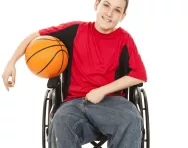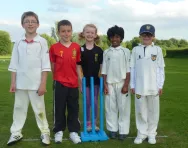Coping with hypermobility at school

Is your child exceptionally flexible? Are they always bending their fingers back and clicking their joints? They could be among the five per cent of the population who have hypermobility.
‘Often, hypermobility becomes apparent when children start school and there are more demands on them, such as controlling a pencil and taking part in PE lessons,’ says Dr Jane Simmonds, senior teaching fellow and researcher at UCL Great Ormond Street Institute of Child Health with a special interest in hypermobility, and spokesperson for the Association of Paediatric Chartered Physiotherapists.


Boost Your Child's Learning Today!
- Start your child on a tailored learning programme
- Get weekly English & maths resources sent direct to your inbox
- Keep your child's learning on track
So how can you tell if your child is hypermobile, and what can be done to make school life easier for them?
What is hypermobility?
Hypermobility means a person’s joints are more flexible than other people’s. Children might think of themselves as ‘double jointed.’
‘There is a whole spectrum of flexibility, from very bendy to very stiff,’ says Jane. ‘Hypermobility itself can be a normal part of child development. It can even be an asset: many hypermobile people are gifted athletes, gymnasts or dancers. It’s only when it’s symptomatic that it becomes a problem.’
If hypermobility causes your child troublesome symptoms, it’s known as generalised joint hypermobility spectrum disorder (gHSD).
‘It’s determined by a number of factors, including the pliability of connective tissue, the shape of the joints themselves, muscle tone and hereditary factors,’ Jane explains. ‘It often becomes more evident in girls during puberty, as hormones increase laxity.’
Some children have gHSD alongside another condition such as developmental co-ordination disorder, also known as dyspraxia, which can increase their difficulties.
What are the symptoms?
Your child might be diagnosed with gHSD if they have hypermobile joints and also have the following symptoms:
- Pain or stiffness in their joints or muscles
- Frequent strains and sprains
- Fatigue
- Poor balance and coordination
- Joints that dislocate easily
- Thin, stretchy skin
How is generalised joint hypermobility assessed?
If you suspect hypermobility, your child’s GP or physiotherapist may undertake a test of their flexibility and give them a ‘Beighton score.’ They will check if they can:
- Bend the knees backwards beyond 10 degrees
- Bend an elbow backwards beyond 10 degrees
- Bend a thumb backwards onto their forearm
- Bend a little finger back by more than 90 degrees
- Stand with their knees straight and put their hands flat on the floor
If your child can do six of these manoeuvres they are said to be hypermobile. If, in addition, they have had pain in four or more joints for at least three months, they are likely to have gHSD. This was previously known as joint hypermobility syndrome.
If they have additional skin and connective tissue signs such as recurrent dislocations, they may have a condition known as hypermobile Ehlers-Danlos syndrome (hEDS).
How might hypermobility affect your child at school?
Many hypermobile children cope very well with school, but gHSD and hEDS can cause some difficulties.
‘Problems with handwriting are quite common, as children can struggle to hold and control their pencil correctly,’ says Jane. ‘Their participation in PE can also be affected by pain and joint instability.’
Some children can be quite fidgety, as this stops their joints stiffening. Sitting cross-legged on the floor can be difficult, too. They may tire easily, and need time to rest during the school day.
Hypermobile children may also have toileting accidents, although this should improve as they get older.
What are the treatment options?
Hypermobility is a body type and as such there is no cure. The treatment therefore focuses on minimising the symptoms.
Children might be referred to a physiotherapist and/or an occupational therapist to help improve their balance, coordination, muscle strength and fitness so their joints are better protected.
‘There’s evidence that children do better when their families are involved with their treatment, so if your child is given exercises to do, try to do them with them so they don’t feel singled out,’ says Jane.
Some children will see a podiatrist, especially if they have flat feet with no arch and unstable ankles. Special insoles or orthotic boots might be recommended to improve their walking.
If your child is struggling to accept their condition and feeling different from others, a referral to a psychologist might be made to help them cope with their emotions.
Having warm baths and using hot water bottles or wheat bags on your child’s affected joints can ease their pain and stiffness. Painkillers like children’s paracetamol or ibuprofen can also be used if they’re in pain.
How schools can help children with hypermobility
There are many measures that schools can put in place to make life easier for children with gHSD and hEDS. If they have a physiotherapist or occupational therapist, it’s a good idea for them to liaise with your child’s teacher about specific provisions to help them.
Ideas that might help include:
Encouraging good posture. Children should be encouraged to sit up straight, with their feet flat on the floor. Slouching is easier, but can cause pain. A foam wedge cushion may be used to improve posture.
Providing writing aids. Ergonomic pens and pencils or pencil grips may help your child control their pencil. Using a writing slope may also be helpful. They can be encouraged to warm up their hands before writing, for example by pulling each finger gently and clenching and unclenching their hands. They should be allowed to take breaks when writing, and/or to use a tablet or laptop if typing is easier.
Allowing rest breaks. Your child may need time to rest or stretch during the day. ‘It’s helpful if schools can provide a place where children can rest or wriggle to prevent stiffness,’ says Jane.
Not sitting on the floor. Some children find it uncomfortable to sit on the floor, especially cross-legged. They may prefer to sit on a chair or bench, or to sit at the end of the row in assembly so they can stretch their legs.
Adapting PE to their needs. Children with gHSD and hEDS should be encouraged to join in with PE as far as possible. ‘This is especially important as some UK research has shown that hypermobile children who are overweight are 12 times more likely to develop symptoms in adolescence,’ Jane says. Your child should wear supportive trainers and exercises may need to be adapted to avoid high impact on their joints. Schools might consider activities that the whole class can join in with, like Pilates.
Toilet passes. If your child is prone to accidents, they should be allowed to use the toilet whenever they need to, and not be told to wait. Some children like to have a pass that they give to their teacher to avoid drawing attention to themselves.
Extra time. Hypermobile children may qualify for extra time in formal exams like SATs. This should be discussed with their teacher, GP or therapists.
Where to get more advice
The following organisations provide support and advice to families dealing with hypermobility:
- Hypermobility Syndromes Association (HMSA), www.hypermobility.org, 033 3011 6388.
- Ehlers-Danlos Support UK (EDS), www.ehlers-danlos.org, 0800 907 8518.
- The Ehlers-Danlos Society, www.ehlers-danlos.com
'She'll never be able to do all her work by hand'
Louise is mum to Evie, six, who has marked gHSD
‘Evie was a floppy baby, and had considerable fine and gross motor delay. She was late to walk and talk, and generally missed most of her milestones. The ligaments in her hands and feet are the worst affected, and although she shows no sign of pain, she’s often very tired.
‘At school, her biggest issue is writing: it’s often illegible. She needs help with dressing as she can’t do buttons or laces, and in PE, she struggles with balancing and jumping.
‘Evie can walk with the aid of orthotic boots, but she tires easily and can’t manage long distances, so she sometimes uses a wheelchair.
‘Evie is now in Year 2, and her school has put various measures in place to help her. She has support chairs in her classroom and the dinner hall, and has special cutlery, scissors and pencil grips. The occupational therapist has advised that she’ll never be able to do all her work by hand, so we’ve provided an iPad and she needs extra time to complete her work. She also needs help in PE due to the risk of dislocation and long-term damage.’

Give your child a headstart
- FREE articles & expert information
- FREE resources & activities
- FREE homework help








